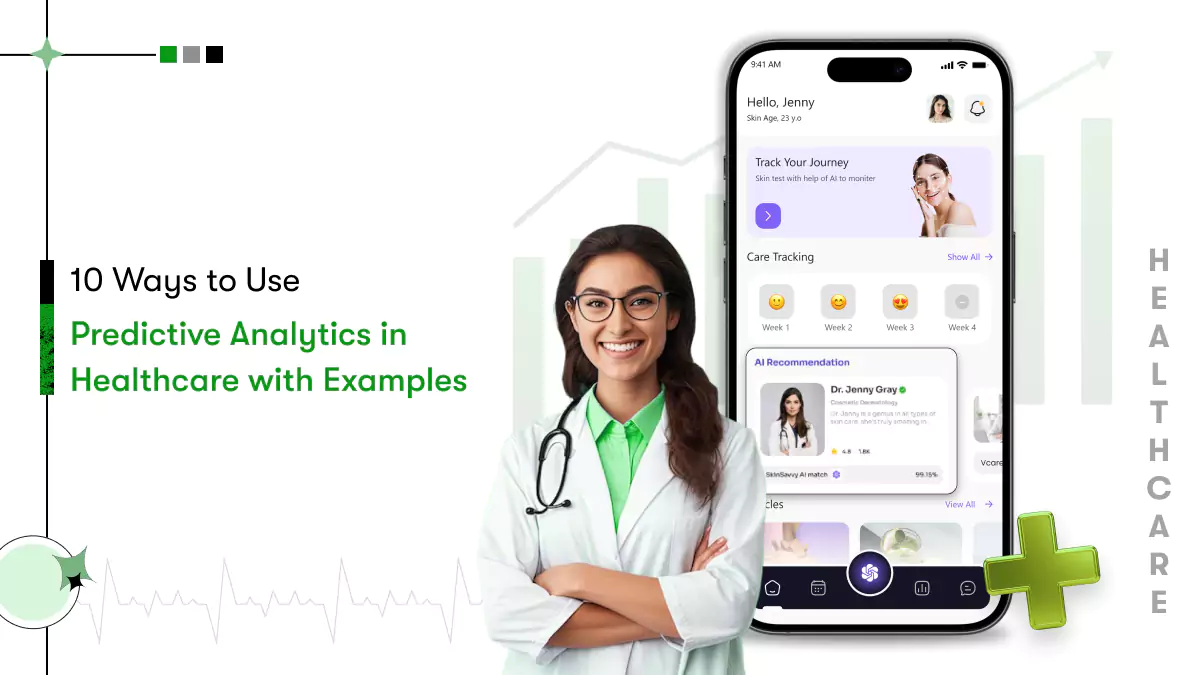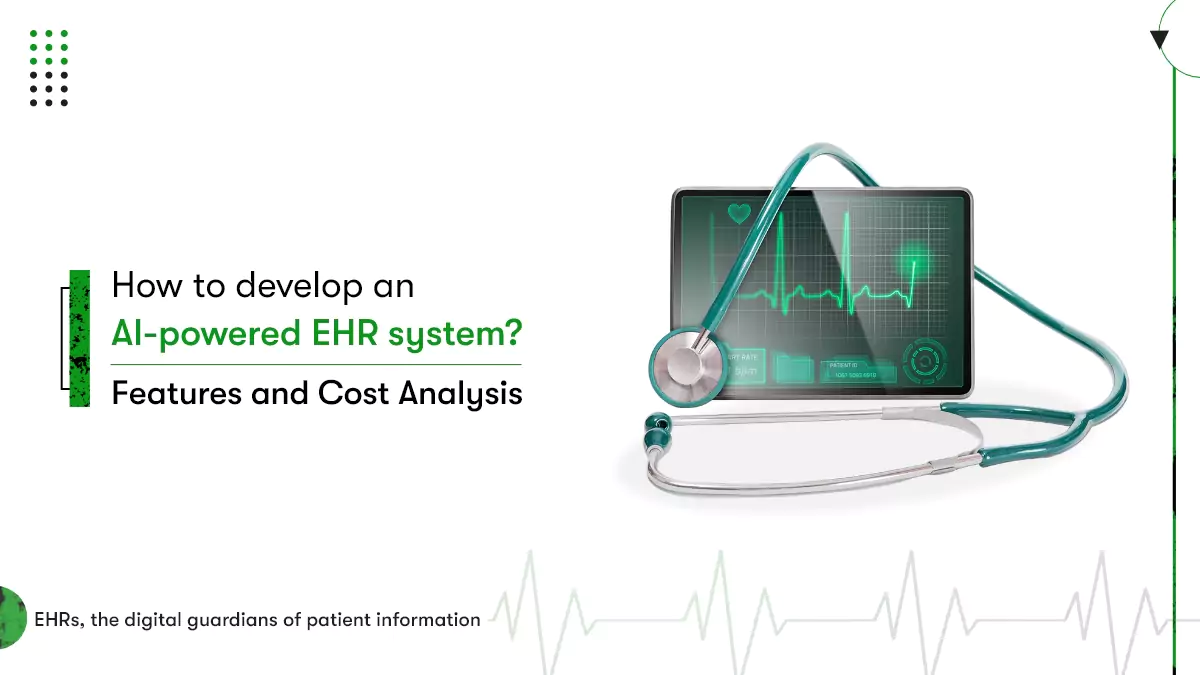Every healthcare organisation today is being asked to do more with less. Fewer staff. Tighter budgets. Higher patient expectations. At the same time, the pressure to deliver faster, safer, and more personalised care continues to grow. This is where predictive analytics in healthcare examples demonstrate how data-driven solutions can help providers meet rising demands without compromising quality.
This is where predictive analytics applications in healthcare become a game-changer. The use of predictive analytics in healthcare helps hospitals, clinics, and health systems use their existing data to see what’s coming next. Whether it’s spotting early signs of illness, avoiding equipment shortages, or preventing readmissions, predictive analytics turns guesswork into action and this is clearly reflected in real-world predictive analytics in healthcare examples.
By 2025, the global market for health-related financial analytics using big data is expected to grow beyond 13 billion US dollars. Healthcare leaders everywhere are investing in technology that helps them stay ahead, not just keep up.
In this blog, you’ll explore predictive analytics in healthcare examples and the benefits of predictive analytics in healthcare. Each one includes predictive analytics applications in healthcare with a practical example. These examples demonstrate how organisations are solving problems before they even arise.
If you’re planning for the future of healthcare, this is where it starts.
1. Early Disease Detection and Prevention

Predictive analytics for early disease detection means identifying health risks before symptoms even appear. Predictive models analyse patient data such as medical records, lab results, lifestyle habits, and wearable inputs. This helps detect conditions like diabetes, cancer, or heart disease early enough to prevent or delay serious outcomes.
Why It Matters?
For decision-makers, the use of predictive analytics in healthcare is about more than early detection. It helps reduce treatment costs, improve outcomes, and enable proactive care. Early intervention can save millions and strengthen value-based care performance.
Key Challenges in Early Disease Detection and Prevention
Despite medical advances, early detection remains one of the biggest gaps in healthcare. Many life-threatening conditions go undetected until it’s too late. Here’s what’s holding healthcare back from truly proactive care.
- Diseases including cancer, heart failure, and kidney disease are often diagnosed too late.
- Routine checkups miss silent health deterioration.
- Healthcare systems are overwhelmed with treating illness, not preventing it.
- Providers lack the tools to predict risks without advanced AI support.
How Predictive Analytics Solve It?
Predictive analytics applications in healthcare use machine learning models trained on millions of patient records to detect hidden patterns. These models consider factors like genetics, lifestyle, medications, and real-time vitals to generate risk scores for each patient. These scores alert care teams to who needs screening or preventive action before illness takes hold, as seen in various predictive analytics in healthcare examples.
Predictive Analytics in Healthcare Example For Early Disease Detection and Prevention
The NHS in England is launching its new AI tool Aire-DM, developed at Imperial College London. This predictive analytics use case in healthcare utilises ECG readings from a patient that will link with their risk of type 2 diabetes up to 13 years before the actual disease kicks in. The alarming feature gives patients and doctors a very big head start.
Instead of waiting for symptoms, this system makes use of hidden warning signs and saves the process early. It encourages preventive actions such as lifestyle modification by changing the diet, managing stress, or becoming more active. Long-term complications and future expenditures on treatment might simply be eliminated.
That’s exactly how healthcare app development for early disease detection is transforming care from reactive to preventive.
Benefits In Early Disease Detection
By detecting health risks early, predictive analytics applications in healthcare help providers move from crisis response to proactive care. These benefits are clearly demonstrated in predictive analytics in healthcare examples, showing why it’s becoming a must-have in modern healthcare.
- Reduces emergency admissions and ICU costs
- Improves patient outcomes and satisfaction
- Increases quality scores tied to value-based care
- Strengthens institutional reputation for preventive, AI-enabled care
These outcomes are only possible when predictive models are applied with the right strategy and execution. For a deeper understanding of how to build and apply such systems across your organisation, explore our complete predictive analytics in healthcare guide.
2. Predictive Hospital Resource Management

Predictive hospital resource management uses predictive models to forecast patient demand and allocate beds, staff, and equipment in advance. It helps hospitals stay ready for surges or outbreaks without overstaffing or overspending.
Why It Matters?
Hospitals face staffing shortages, capacity issues, and financial strain. Predictive analytics to optimise hospital resource allocation reduces burnout and maintains care quality. It’s a tool for both cost control and crisis readiness.
Key Challenges in Predictive Hospital Resource Management
Managing hospital resources without real-time insights leads to costly inefficiencies. These persistent challenges reveal why traditional resource planning is no longer enough.
- ERs and ICUs frequently operate near or over capacity.
- Staff burnout and turnover are accelerating, especially post-COVID.
- Manual forecasting methods are often reactive, not real-time.
- Bed and supply shortages lead to care delays and patient dissatisfaction.
How Predictive Analytics Solve It?
Predictive analytics applications in healthcare models use historical admissions, seasonal trends, demographic data, and real-time signals (like flu spikes or local outbreaks) to forecast:
- Patient volume by department
- Required staffing levels by shift
- Equipment and bed demands
This enables the administration to take pre-emptive action on schedule alterations, optimise ICU readiness for the utmost convenience, and prevent over-utilisation or under-preparedness.
Predictive Analytics in Healthcare Example For Predictive Hospital Resource Management
The use of predictive analytics in healthcare helps hospitals plan ahead. By analysing past data and current trends, it can forecast how many patients are likely to arrive on a given day. This includes emergency visits, seasonal spikes, or even responses to local events. With this information, hospital teams can prepare beds, staff, and equipment before the rush happens, as seen in many predictive analytics in healthcare examples.
An example of predictive analytics use cases in healthcare for managing resources is if data shows a likely flu surge next week, care providers can add shifts and open more beds in advance. This avoids last-minute decisions, overcrowding, and staff burnout. While detailed public case studies are still growing, many health systems are now testing these models to manage ICU load, emergency admissions, and staffing. The goal is simple. Predict demand early, respond quickly, and keep care smooth even during the busiest times.
Benefits In Smarter Hospital Resource Management
Smarter resource planning starts with better predictions. These benefits show how predictive analytics keeps hospitals ready, efficient, and resilient.
- Better preparedness during public health emergencies
- Optimised staffing reduces overtime and burnout
- Fewer cancelled procedures due to resource constraints
- Higher operational efficiency and reduced overhead costs
3. Real-Time Remote Patient Monitoring & Alerts

Predictive analytics in telemedicine and remote patient monitoring in real-time tracks patient vitals and behaviours outside of hospitals. It includes wearable devices and mobile health tools. When abnormal trends are detected, automated alerts are sent to clinicians so they can intervene before a medical emergency occurs.
Why It Matters?
Hospitals have to cut re-admissions and manage ageing populations. The use of predictive analytics in healthcare analytics helps monitor high-risk patients remotely, improving outcomes and easing hospital load. It turns care from reactive to proactive.
Key Challenges in Real-Time Remote Patient Monitoring
Without real-time monitoring, subtle health changes often go unnoticed. These challenges show why remote patient tracking needs a smarter approach.
- Chronic condition patients often deteriorate between follow-up appointments.
- Late interventions lead to emergency visits or ICU admissions.
- Clinicians can’t track patients once they leave the hospital.
- Manual monitoring systems lack real-time responsiveness.
How Predictive Analytics Solve It?
Predictive analytics uses continuous data from wearables, smart devices, and home monitoring tools (like heart rate, oxygen levels, mobility, and glucose) to spot subtle shifts in health. If a patient’s vitals indicate a high risk of deterioration, clinicians are automatically notified, enabling timely action like medication changes, home visits, or virtual check-ins. This healthcare system works round the clock, allowing for early action before any emergency situation occurs.
Predictive Analytics in Healthcare Example For Real-Time Remote Patient Monitoring
HealthSnap is a remote patient monitoring (RPM) platform that connects patients’ health devices to their care teams. It gathers real-time data such as blood pressure, glucose levels, heart rate, and oxygen saturation. This information is analysed using predictive models to detect early warning signs before symptoms appear.
If the system identifies a concerning trend, like rising blood pressure or unstable glucose, it sends alerts to the healthcare provider. This allows for timely action, helping to prevent hospital visits and improve patient outcomes. HealthSnap also integrates with electronic health records, making it easier for doctors to manage care remotely. It enables continuous, personalised monitoring beyond the hospital walls.
Benefits In Real-Time Remote Patient Monitoring & Alerts
From freeing up beds to supporting hospital-at-home models, predictive analytics offers clear strategic advantages for modern healthcare providers.
- Reduces readmission rates and emergency visits
- Frees up hospital beds for critical cases
- Enables 24/7 care continuity without added staff burden
- Enhances patient satisfaction and remote engagement
- Supports NHS payers’ shift to hospital-at-home models
4. Reducing Hospital Readmissions

Reducing hospital readmissions with predictive analytics applications in healthcare means using patient data and machine learning models to identify those most likely to return to the hospital shortly after discharge. This allows care teams to intervene early, offer support, and avoid costly readmissions.
Why It Matters?
Hospitals must reduce 30-day readmission rates to avoid penalties and relieve system pressure. In the US, Medicare’s HRRP impacts reimbursement. In the UK, the NHS focuses on freeing up capacity. Predictive analytics Use cases in healthcare for reducing re-admissions enables a smarter, more targeted approach, helping providers deliver the right follow-up care to the right patients.
Key Challenges in Reducing Hospital Readmissions
Reducing readmissions is still a major challenge for hospitals. These issues reveal why many patients return soon after discharge.
- One in every 5 patients is readmitted within 30 days after discharge.
- Many readmissions happen due to unmonitored symptoms, medication issues, or lack of post-discharge support.
- Hospitals often use generalised discharge protocols, missing high-risk cases.
- Readmissions increase costs and hurt performance metrics.
How Predictive Analytics Solve It?
Predictive analytics tools analyse factors like discharge notes, vitals, lab results, diagnoses, and social determinants (like housing or transport access) for analysis of being readmitted.
These scores help healthcare teams:
- Identify at-risk patients before discharge
- Schedule closer follow-ups or remote monitoring
- Coordinate community or home-based care
- Educate patients and caregivers proactively
Instead of treating every discharged patient the same, providers can focus efforts where they matter most.
Predictive Analytics in Healthcare Example For Reducing Hospital Re-admissions
Corewell Health implemented a predictive analytics tool to identify patients at high risk of readmission. By analysing factors such as discharge notes, vital signs, lab results, and social determinants of health, the system could predict which patients were more likely to be readmitted. This allowed healthcare teams to provide targeted interventions, including closer follow-ups and remote monitoring, to those patients. As a result, Corewell Health prevented 200 readmissions and achieved $5 million in cost savings. This stands out as one of the most impactful predictive analytics in healthcare examples.
This initiative not only improved patient outcomes but also enhanced compliance with value-based care targets. By focusing resources on patients who needed them most, Corewell Health demonstrated how predictive analytics could be a powerful tool in reducing hospital readmissions and optimising healthcare delivery.
Benefits In Reducing Hospital Re-admissions
Reducing re-admissions isn’t just about saving costs. It’s about delivering smarter, safer care after discharge. These benefits show why predictive analytics is key.
- Reduces financial penalties tied to high re-admission rates
- Increases efficiency by lowering unnecessary bed occupancy
- Improves patient outcomes and long-term recovery
- Enhances compliance with value-based care targets and CQC/NHS standards
- Builds trust by showing proactive, patient-first discharge care
5. Personalised Treatment Planning

Predictive models for personalised healthcare treatment mean building care pathways tailored to the unique needs of each person’s past medical data, genetics, lifestyle factors, and treatment responses; predictive models recommend what works best for that specific individual, not just what works on average.
Why It Matters?
Healthcare leaders continually strive to improve outcomes and reduce unnecessary treatments. One-size-fits-all care is costly and often ineffective. Predictive analytics enables targeted, evidence-based care that leads to fewer complications, faster recovery, and lower costs.
Key Challenges in Personalized Treatment Planning
Personalised care is still out of reach for many. These challenges show why generic treatment plans often fall short.
- Treatments are often based on broad guidelines, not individual patient factors.
- Trial-and-error approaches lead to adverse drug reactions or delays in recovery.
- Patient non-compliance is high when treatment doesn’t feel tailored.
- Wasted time and resources from failed treatment regimens.
How Predictive Analytics Solve It?
By applying machine learning to large patient datasets (including genomic data, clinical history, demographics, and lifestyle), predictive analytics can:
- Recommend personalised medication plans
- Predict treatment response likelihood
- Adjust dosages in real time based on ongoing data
- Suggest alternative therapies before first-line options fail
This ensures patients receive what’s most likely to work for them, not the average case.
Predictive Analytics in Healthcare Example For Personalized Treatment:
IBM Watson for Oncology is a predictive model-powered clinical decision support system that uses a natural language processing model. It uses predictive analytics to analyse a patient’s medical history, lab results, genetic data, and clinical notes. Based on this data, it provides oncologists with evidence-based treatment options tailored to the individual patient.
The system organises recommendations into categories like: recommended, for consideration, and not recommended. This helps doctors compare different treatment paths with greater clarity. In clinical settings, Watson for Oncology has shown high alignment with expert decisions, particularly for cancers such as breast, colon, and ovarian. By combining predictive models with global oncology data, the platform supports faster, more consistent, and personalised treatment planning. It reduces trial and error and helps oncologists deliver care that is precise and well-supported by clinical evidence.
Benefits In Personalized Treatment Planning
Personalised care powered by predictive analytics leads to better results for both patients and providers. These benefits show why precision matters.
- Increases treatment success rates and lowers rework
- Improves patient adherence and satisfaction
- Reduces adverse events, malpractice risk, and unnecessary testing
- Positions the institution as a leader in precision medicine and digital health
- Supports regulatory push toward outcome-based care contracts
6. Mental Health Risk Prediction

Mental health risk prediction uses predictive models to identify patients at risk of conditions like depression, anxiety, or PTSD before symptoms worsen. It analyses digital behaviour, clinical history, and biometric data to flag early warning signs and support timely intervention.
Why It Matters?
Mental health disorders are rising, especially post-pandemic. In the UK, the NHS has seen record demand for mental health services. In the USA, healthcare systems face high costs tied to untreated mental health conditions, from ER visits to workplace absenteeism. With staff shortages and delays, predictive analytics helps close healthcare gaps, enable early action, and manage caseloads efficiently.
Key Challenges in Mental Health Risk Detection
Timely support is often out of reach in mental health care. These challenges reveal why early risk detection is so difficult.
- Many mental health issues go undetected until a crisis occurs.
- Stigma and long wait times delay treatment-seeking.
- Mental health screenings are inconsistent across care settings.
- Providers lack real-time insight into subtle behavioural changes.
How Predictive Analytics Solve It?
Predictive models process a range of data, such as:
- EHRs and previous diagnoses
- Social and behavioural data (app usage, engagement patterns)
- Sleep and stress levels from wearables
- Missed appointments or medication gaps
The system then flags individuals at risk of a mental health decline, triggering alerts for outreach, virtual consultations, or additional screening before the situation worsens.
Predictive Analytics in Healthcare Example For Early Mental Health Risk Detection
The PMC developed a predictive model using electronic health records (EHRs) to detect early signs of upcoming mental health crises. Researchers analysed data from 17,122 patients treated in outpatient mental health services between 2012 and 2018.
The goal was to predict whether a patient would experience a mental health crisis within the next 28 days. It can include hospitalisation or emergency intervention. The model used clinical history, recent service use, diagnosis patterns, medication changes, and other structured EHR data.
The results showed that the model accurately identified high-risk individuals. This allowed mental health professionals to step in early, prioritise care, and reduce preventable crisis events. It is a strong example of how predictive analytics can move mental health care from reactive treatment to proactive prevention, as seen in successful predictive analytics in healthcare examples.
Benefits In Mental Health Risk Prediction
By identifying risks early, predictive analytics helps mental health teams focus resources where they’re needed most. Here’s how.
- Reduces emergency psychiatric admissions and crisis care costs
- Improves patient safety and care continuity
- Enables mental health professionals to prioritise high-risk cases
- Strengthens trust and engagement with vulnerable populations
- Aligns with national mental health improvement goals in the NHS and CMS
7. Predictive Emergency Triage

Predictive emergency triage uses AI-driven risk models to assess a patient’s condition in real-time and determine how urgent their case is, even before a full clinical evaluation is done. By analysing vitals, symptoms, and medical history, predictive analytics helps emergency departments prioritise care faster and more accurately.
Why It Matters?
Emergency rooms are always overcrowded, and clinicians often make rapid decisions with limited data. The risk of human error is high, and delays in treating critical cases can be fatal. Predictive analytics provides real-time insights that improve triage accuracy and speed up care for high-risk patients.
Key Challenges in Predictive Emergency Triage
Manual decisions can sometimes oversee critical risks. These issues show the need for smarter, faster decision support in emergency care.
- Emergency departments often lack real-time risk-scoring tools.
- Overcrowding leads to long wait times and delayed treatment for critical cases.
- Triage is still largely manual and subjective.
- Inconsistent prioritisation increases mortality and malpractice risks.
How Predictive Analytics Solve It?
Predictive models analysis:
- Presenting symptoms (via intake forms or voice triage tools)
- Vital signs captured at check-in
- EHR data (chronic conditions, past visits, medications)
- Real-time patient queue flow
Based on this, the system assigns a risk score to each patient, helping staff prioritise who needs urgent care versus who can wait. It’s fast, data-backed, and continuously updated as more information becomes available.
Real-World Predictive Analytics in Healthcare Example for Emergency Triage
UCSF Health partnered with GE Healthcare to implement the Mural Virtual Care Solution, a predictive analytics platform designed to support critical care and emergency triage decisions. The system integrates with patient monitoring devices and electronic health records (EHRs) to collect real-time data such as vital signs, lab results, and ventilator settings.
Using machine learning algorithms trained on historical ICU and ER data, the platform continuously analyses patient conditions to predict clinical deterioration, including respiratory failure, sepsis, and cardiac arrest. These predictions are displayed through risk scores and alerts, allowing emergency and critical care teams to triage high-risk patients faster and direct immediate care where it is most needed. This approach reflects how predictive analytics in healthcare examples are transforming emergency response.
This initiative is already helping UCSF clinicians reduce response time in critical cases, allocate ICU beds more efficiently, and improve patient outcomes through earlier interventions.
Benefits In Improving Emergency Triage
Smarter triage decisions lead to faster care and better outcomes. Here’s how predictive analytics is reshaping emergency response.
- Reduces ER overcrowding by streamlining triage
- Improves time-to-treatment for high-acuity cases
- Supports clinicians with real-time risk scoring
- Enhances patient outcomes and emergency department performance metrics
- Reduces litigation risk from mis-triage

8. Healthcare Workforce Planning

Healthcare workforce planning powered by predictive analytics helps hospitals and care networks forecast how many clinicians, nurses, specialists, or support staff they will need, and when. It uses historical data, patient inflow trends, and seasonal or regional events to help healthcare leaders anticipate staffing needs in advance rather than scrambling to react.
Why It Matters?
Staff shortages are one of the biggest problems in healthcare delivery today. In the UK, NHS Trusts face record vacancy rates across clinical roles. In the USA, hospitals are spending billions annually on agency staffing and overtime due to poor forecasting. Predictive analytics in healthcare enables smarter workforce planning, reducing burnout, cutting excess labour costs, and ensuring patients get timely, high-quality care.
Key Challenges in Healthcare Workforce Planning
Managing the healthcare workforce without real-time insights leads to inefficiencies and burnout. These challenges reveal why a smarter approach is needed.
- Staffing is reactive based on guesswork or outdated scheduling models.
- Surges (like flu season or viral outbreaks) catch hospitals unprepared.
- Understaffing leads to burnout; overstaffing wastes resources.
- Manual workforce planning can’t keep up with real-time demand shifts.
How Predictive Analytics Solve It?
Predictive models analysis:
- Historical staffing and shift performance
- Patient volumes by season, speciality, and facility type
- Local disease trends and public health alerts
- Workforce availability, turnover, and leave patterns
This enables HR and operations teams to:
- Forecast staffing needs for specific departments or dates
- Build dynamic shift schedules that adapt to the expected load
- Prepare contingency plans for high-risk periods
- Reduce dependency on agency hires or emergency contracts
Predictive Analytics in Healthcare Example for Better Workforce Planning
ShiftMed, a healthcare staffing platform, leverages predictive analytics to assist healthcare organisations in forecasting patient demand and optimising staffing levels. By analysing historical data, seasonal trends, and patient acuity, ShiftMed’s system enables proactive workforce planning. This approach helps in reducing overtime, ensuring adequate coverage during peak times, and minimising reliance on costly agency staff.
For instance, SSM Health, a non-profit health system, partnered with ShiftMed to address staffing challenges. By utilising ShiftMed’s predictive analytics and on-demand staffing solutions, SSM Health achieved significant labour cost savings and improved workforce stability.
This example illustrates how predictive analytics can be effectively applied to healthcare workforce planning, leading to improved operational efficiency and patient care.
Benefits In Effective Workforce Planning
Predictive analytics helps healthcare teams stay ahead of demand with smarter staffing decisions. These benefits highlight its impact on workforce efficiency and care quality.
- Improves workforce utilisation and reduces agency dependence
- Minimises staff burnout and turnover
- Enables safer clinician-to-patient ratios
- Aligns workforce planning with demand-driven care delivery
- Enhances HR planning and budgeting accuracy
9. Medical Equipment & Inventory Optimization

Medical equipment and inventory optimisation making use of predictive analytics in healthcare refers to the ability to forecast future demand for critical supplies such as ventilators, PPE, surgical tools, and medications so that hospitals stock smartly, reduce waste, and avoid shortages.
Why It Matters?
The COVID-19 pandemic exposed serious weaknesses in healthcare supply chains. Over-ordering led to waste while under-ordering risked lives. Now, healthcare leaders are under pressure to manage inventory more intelligently, ensuring availability without overspending. Predictive analytics use cases in healthcare for equipment and inventory optimisation enable data-driven planning, improving both clinical readiness and financial control. Several predictive analytics in healthcare examples highlight how this approach prevents shortages and reduces operational waste.
Key Challenges in Medical Equipment & Inventory Optimization
Hospitals struggle to balance supply and demand. These issues highlight the urgent need for predictive, data-driven inventory management.
- Hospitals often overstock or understock due to poor forecasting.
- Equipment shortages delay surgeries or emergency care.
- Expired or unused inventory leads to massive financial waste.
- Manual tracking systems fail to align inventory with real-time clinical demand.
How Predictive Analytics Solve It?
By analysing:
- Past usage patterns (by department, season, case type)
- Upcoming appointments and surgical schedules
- Supplier delivery timelines and delays
- Local disease trends (e.g., flu spikes, COVID variants)
Predictive models help procurement and operations teams:
- Forecast precise inventory needs across departments
- Automate restocking alerts before stockouts happen
- Prevent over-purchasing and eliminate expired stock
- Match supply with expected clinical demand—daily or weekly
Predictive Analytics in Healthcare Example for Medical Equipment and Inventory Optimization
The Mayo Clinic has implemented predictive analytics to improve its supply chain operations. By analysing historical data, the clinic can forecast patient demand for various medical supplies and pharmaceuticals more accurately. This enhanced forecasting has led to optimised inventory management, ensuring that essential supplies are available when needed, thereby improving patient care.
The integration of artificial intelligence (AI) and predictive analytics into healthcare supply chain management offers significant potential to enhance operational efficiency, reduce costs, and improve decision-making. For example, predictive analytics can analyse historical data to forecast patient demand for medical supplies accurately, ensuring that the right products are available at the right time. This not only minimises stockouts but also reduces excess inventory, leading to significant cost savings. Numerous predictive analytics in healthcare examples highlight how this approach streamlines supply chain operations and boosts readiness.
Furthermore, the application of predictive analytics helps organisations optimise their resource allocation and manage costs more effectively. According to McKinsey & Company, healthcare organisations that implement AI-driven predictive models in supply chain solutions can achieve cost reductions of up to 15% by minimising waste and improving operational workflows. Several predictive analytics in healthcare examples support these findings, demonstrating measurable improvements in efficiency and cost control.
Benefits In Medical Equipment and Inventory Optimization
Smarter forecasting leads to fewer shortages, less waste, and better preparedness. Here’s how predictive analytics transforms equipment and inventory management.
- Ensures critical equipment is always available
- Reduces waste from over-ordering and expired stock
- Lowers procurement costs through smarter forecasting
- Increases operating room efficiency and care continuity
- Enhances resilience during public health emergencies
10. Fraud Detection and Billing Accuracy

Fraud prevention in insurance using predictive analytics and billing accuracy in healthcare means using AI to analyse billing data, treatment records, and patient histories to detect irregular patterns, duplicate charges, or suspicious claims. The goal is to catch errors and fraud early—before they cost the system millions.
Why It Matters?
Healthcare fraud and billing errors drain billions from systems like Medicare, private insurers, and the NHS every year. These errors not only inflate costs but also damage patient trust and expose institutions to compliance risks.
Predictive analytics helps decision-makers protect revenue, maintain compliance, and ensure every claim is accurate and justified without slowing down operations.
Key Challenges in Fraud Detection and Billing Accuracy
- Fraudulent billing and coding errors are often detected months after the fact.
- Manual audits are slow, expensive, and often miss subtle patterns.
- Overbilling, underbilling, and claim mismatches lead to payer disputes.
- Repeated billing mistakes can trigger penalties or audits from regulators.
How Predictive Analytics Solve It?
Predictive analytics applies advanced algorithms to scan thousands of billing records, clinical notes, and treatment histories in real-time. It detects patterns and outliers that would take human auditors weeks or even months to notice.
Here’s a to-do list of what is predictive analytics in healthcare bring to your organisation:
- Automatically flag unusual billing activity, such as duplicate claims or services that don’t match the diagnosis
- Identify high-risk providers or departments that consistently deviate from expected billing behaviour
- Cross-check clinical data with coding entries to ensure accuracy before claims are submitted
- Catch fraud indicators early, helping prevent financial losses and payer disputes
By embedding predictive models into your billing workflow, you move from reactive fraud investigation to real-time prevention and revenue protection.
Predictive Analytics in Healthcare Example for Fraud Detection and Billing Accuracy
The Massachusetts Medicaid program, known as MassHealth, implemented a predictive modelling system to proactively detect and prevent healthcare fraud. This system analyses historical claims data to identify patterns indicative of fraudulent activities, enabling the organisation to take preventive measures before fraudulent claims are processed.
Key Outcomes:
- Enhanced Visibility: The system provided MassHealth with unprecedented visibility into data, allowing for the rapid identification of excessive usage patterns and unusual billing behaviours.
- Compliance with Federal Regulations: By enabling real-time or near-real-time analysis, the system helped MassHealth comply with federal prompt payment rules, reducing manual review efforts and expediting the claims process.
- Continuous Learning: The predictive model incorporates inherent learning capabilities, allowing it to adapt to changing fraud patterns over time, thereby improving its accuracy and effectiveness.
- Cost Savings: The implementation of this predictive analytics solution allowed MassHealth to move from a reactive “pay-and-chase” approach to a proactive fraud prevention strategy, leading to significant cost savings and improved program integrity.
This case exemplifies how predictive analytics can be leveraged to enhance fraud detection and billing accuracy in healthcare, resulting in financial savings and more efficient operations.
Benefits In Fraud Detection and Billing Accuracy
Predictive analytics helps healthcare providers catch billing issues before they become costly. These benefits show how it strengthens financial accuracy and trust.
- Protects revenue by preventing overpayments and under-reimbursements
- Reduces audit risk and ensures regulatory compliance
- Improves relationships with insurers and payers
- Enhances financial transparency and operational trust
- Reduces time and cost of manual reviews or investigations
Final words
Predictive analytics is already changing how healthcare works. It helps providers find risks early, use resources better, and improve patient care. The predictive analytics in healthcare examples shared in this blog show how real hospitals and health systems are using data to make better decisions every day. If your organisation is ready to take the next step, working with a trusted healthcare predictive analytics consulting partner can help you get there faster and with more confidence.













 Contact Information
Contact Information